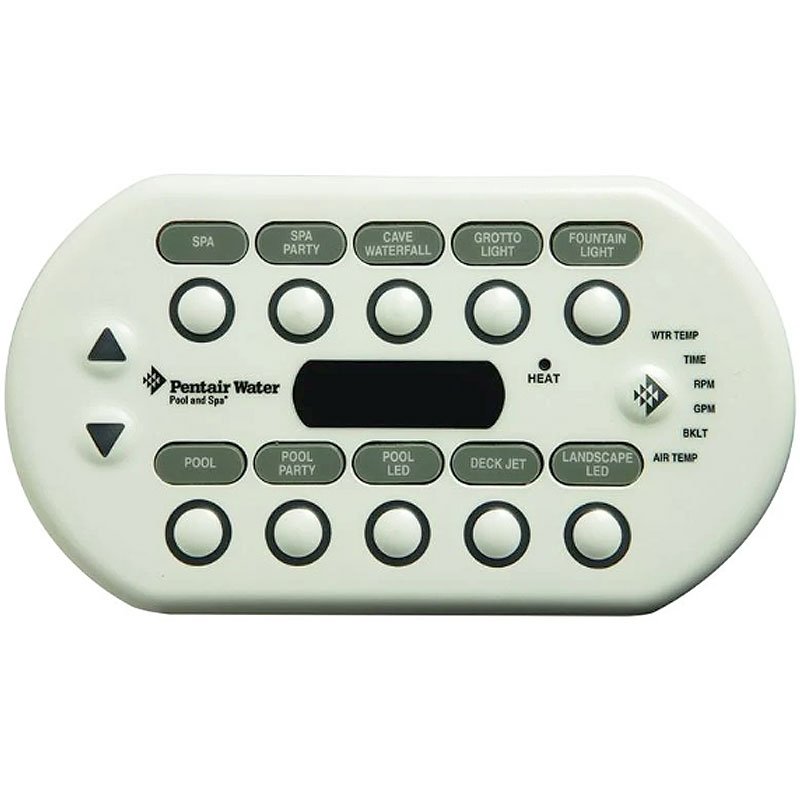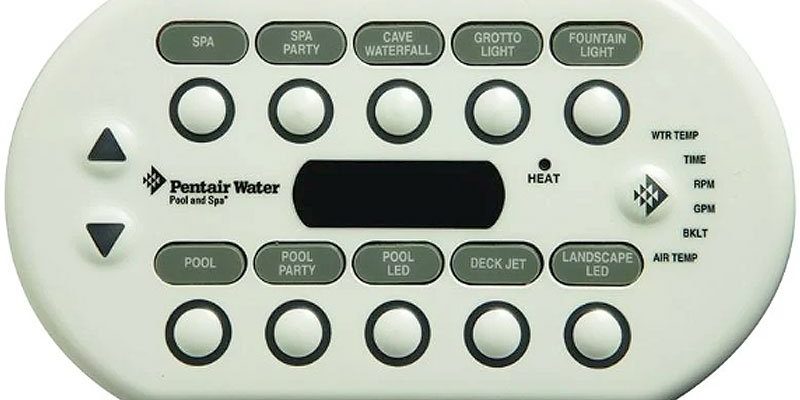
Let’s be honest, nobody wants to ruin a relaxing soak by worrying about electronics and water mixing like oil and vinegar. If you’ve ever second-guessed grabbing your Pentair remote with wet hands or worried about it tumbling in, you’re not alone. Let me walk you through exactly how waterproof these remotes are, what the ratings really mean, and the best ways to keep things safe—without getting too technical or boring.
What Kind of Remote Does Pentair Make for Spas?
Before we can dig into how waterproof a Pentair spa remote is, it helps to know what type of remote we’re actually talking about. Pentair offers a few remote options for spa and pool control, but the most common ones you’ll run into are the Pentair EasyTouch Wireless Remote and the Pentair SpaCommand Spa-Side Remote.
Here’s the thing: the Pentair EasyTouch remote is designed for you to use at a distance from the spa equipment—think poolside lounging or managing your system from the comfort of your patio chair. The SpaCommand, on the other hand, is made to be installed right at the spa’s edge, usually in a special housing.
What’s interesting is that not all Pentair remotes are built with the same level of water resistance. Some are meant to be splash-proof, while others are specifically designed to handle being near water all the time. The bottom line is: you need to know exactly which remote you own, because it impacts how recklessly you can wave it around when your hands are dripping wet.
Are Pentair Spa Remotes Actually Waterproof?
You might be wondering, “Does waterproof mean I can dunk it?” This is where things can get confusing. For most Pentair spa remotes, the term “waterproof” doesn’t mean you can toss it in the water and fish it out later with no issues. Instead, most are considered *water-resistant*.
Let me explain: the Pentair SpaCommand Spa-Side Remote often carries an IP (Ingress Protection) rating, usually something like IPX5 or IPX7. These codes might look like robot names, but they basically tell you how well the device stands up to water. For example, an IPX5 rating means it can handle water splashes from any direction, while IPX7 means it can actually survive being submerged in up to 3 feet of water for about 30 minutes.
But not every Pentair remote is made equal. The EasyTouch wireless remote is *not* designed for dunking or heavy splashing, even if it survives the occasional wet hand. Manufacturers are careful to distinguish between “splash-proof” and “waterproof,” so if you want to be safe, check the exact model’s specs for its IP rating.
The key idea: Most Pentair spa remotes are water-resistant, not truly waterproof. Be careful, especially if you’re tempted to use it inside the hot tub like a rubber duck.
Why Does Waterproofing Matter for Spa Remotes?
Here’s the thing: water and electronics are not friends. Even if a Pentair spa remote claims to be resistant to splashes, long-term exposure to steam, chemicals, or a quick dive at the bottom of the spa can still cause problems.
Let’s talk real-life implications:
- Short circuits: If water seeps inside, the remote’s internal circuit board can short out. It might stop syncing with the pool system or refuse to turn on entirely.
- Corrosion: Spa chemicals and moisture can cause metal parts inside the remote to rust or corrode, making buttons sticky or the battery compartment messy.
- Safety risks: While these devices are low-voltage, a damaged remote can potentially pose shock risks or cause weird system glitches. Better safe than sorry.
So, even if your remote has a decent rating, it’s smart to treat it with a little respect around water. Think of it like your phone—sure, it might survive a splash, but you probably wouldn’t take it swimming on purpose.
How to Use the Pentair Spa Remote Safely
Honestly, most remote mishaps are totally preventable. With just a few good habits, you can keep your Pentair spa remote working and avoid those “Oops!” moments.
Here are some simple tips:
- Keep it dry when possible: Wipe your hands before grabbing the remote, or use a small towel nearby.
- Mount the SpaCommand: If you have a SpaCommand remote, make sure it’s properly installed in its housing at the spa’s edge, not dangling in the water.
- Avoid submersion: If you drop the remote in the spa, fish it out fast, dry it, and remove the batteries if possible.
- Use a protective case: For wireless remotes, some users swear by waterproof pouches or zip bags—especially if kids are around.
Here’s a tiny story: I once saw someone balance their remote on the spa’s edge, only to have a gust of wind blow it right into the bubbles. Don’t be like that guy. Treat your remote like a fragile TV remote—not a bath toy.
Troubleshooting: What to Do If Your Pentair Remote Gets Wet
Alright, accidents happen. Maybe you dropped your EasyTouch remote in the spa, or it got left outside during a rainstorm. Here’s your quick “spa remote CPR” checklist:
- Turn it off (if possible): If your remote has a power button or battery compartment, switch it off right away.
- Remove the batteries: Don’t wait. Pop them out to prevent any chance of short-circuiting.
- Dry thoroughly: Shake off water, pat with a towel, and leave it in a dry, ventilated spot. If you want to go old-school, placing it in a bowl of uncooked rice sometimes helps absorb moisture.
- Wait 24–48 hours: Test the remote only after you’re sure it’s bone-dry. Rushing this can fry the internal circuits for good.
If your remote still won’t sync, code, or reset after drying out, you might need to replace it or call Pentair support for troubleshooting. Don’t risk using a glitchy remote—it’s not worth the headache.
Understanding IP Ratings on Spa Remotes
Let’s decode those IP rating numbers you see in manuals and on websites. The *IP* stands for “Ingress Protection” and uses two digits. The first digit (usually skipped for water protection) rates solid particle resistance, and the second is all about water.
For Pentair spa remotes, the second digit matters most:
- IPX4: Protected against splashes from any angle—but don’t submerge.
- IPX5: Handles water jets and strong splashes—but submersion is risky.
- IPX7: Can survive being submerged (up to 3 feet) for 30 minutes.
So if your model says IPX7, you’re in the safest possible territory (but still, don’t push your luck). The higher the number, the more forgiving it’ll be around accidental dunks. Always look up your exact remote’s IP rating in the manual or on Pentair’s website. It’s worth the 30-second search.
Tip: If the product info or label doesn’t clearly state “waterproof” or give an IPX7 rating, assume it’s not meant for swimming or heavy splashes.
Comparing Pentair Spa Remotes to Universal and Aftermarket Options
Here’s something a lot of folks miss: not all remotes are created equal. Pentair remotes are built specifically for their system, so they usually offer the best integration and safety features—but what about universal or aftermarket remotes?
Some universal remotes claim to work with “most major brands” and might even advertise higher water resistance. But, honestly, they can be hit-or-miss on reliability, pairing, and code compatibility. If you’re the kind of person who likes to tinker and troubleshoot, you might get by, but for peace of mind, sticking with a Pentair remote is almost always the safe move.
*Why?* Because using an off-brand remote might mean giving up advanced features like full spa system sync, reset options, battery life indicators, and even warranty protection. Plus, manufacturers can blame connectivity issues on your third-party device, which means less support if things go wrong.
When Should You Replace a Pentair Spa Remote?
Even the toughest remotes wear out eventually—especially with water exposure, kids, pets, or just normal battery swaps gone wrong. Here are a few signs your Pentair spa remote needs replacing:
- Buttons stop responding, even after cleaning or drying.
- Display goes blank or shows weird error codes that won’t clear with a reset.
- Won’t sync or pair to the spa system, even with fresh batteries and code re-entry.
- Obvious water damage inside the battery compartment or under the casing (smells funky, looks rusty, you know the drill).
If your remote has seen better days, don’t risk system malfunctions. Pentair remotes can be pricey, but they’re worth the investment to keep your spa experience smooth (and safe).
Practical Safety Tips for Using Your Pentair Spa Remote
I know—it’s tempting to treat your spa remote like a waterproof gadget, but a few extra precautions go a long way:
- Designate a safe spot: Keep a small tray or hook near the spa, just out of splash range, so the remote isn’t balancing on a slippery ledge.
- Train guests (and yourself): Remind everyone not to bring the remote into the spa or use it with super-wet hands.
- Check battery life regularly: Swapping old batteries before they leak is way easier than cleaning up corrosion later.
- Have a backup plan: Know how to code, reset, or manually operate your Pentair spa system in case the remote is temporarily out of commission. It’s way less stressful to learn now rather than mid-soak.
Honestly, treating your Pentair spa remote with just a bit of caution means it’ll stay reliable for years. Think of it like your car keys—not something you want to leave in the pool.
Closing Thoughts: Waterproof? Yes… But With Limits
So, is your Pentair spa remote waterproof? The answer is: *sort of*. Most Pentair spa remotes are designed to be water-resistant and can handle splashes, wet fingers, and even a little rain. But unless your specific model says IPX7 or “submersible” in big, bold letters, don’t trust it to survive a deep dive. Protect your investment by keeping it dry, using it safely, and knowing what to do if it takes an unexpected swim.
It all comes down to a bit of common sense and knowing the limits of your gear. Keep your remote dry, treat it with care, and you’ll spend a lot more time enjoying your spa—and a lot less time troubleshooting or shopping for replacements. Happy soaking!
